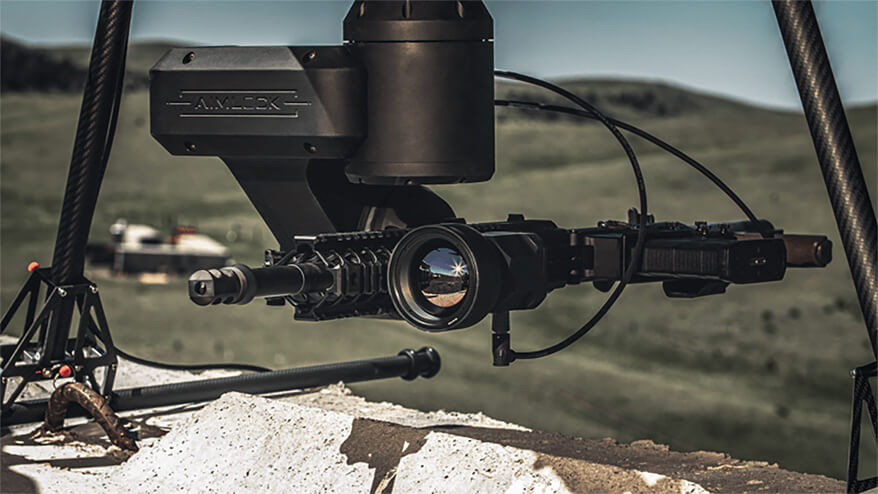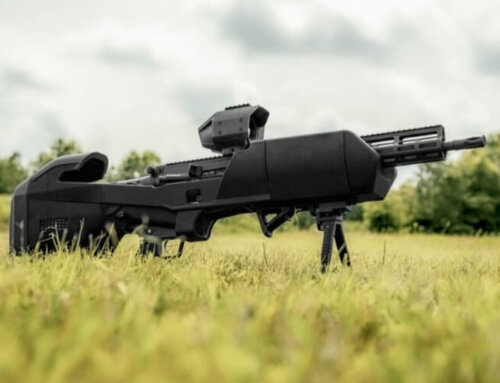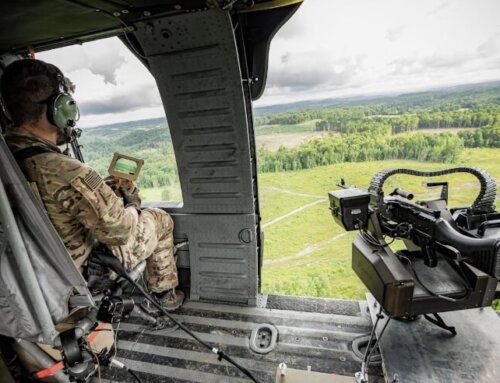NEWS & EVENTS

Counter-Drone Tech Struggles to Keep Up with Evolving Threat
VIRGINIA BEACH, Virginia — During the last year, the Navy alone has spent more than $1 billion shooting down missiles and uncrewed aerial systems in the Red Sea — an expense made unsustainable by the sheer proliferation of relatively inexpensive drones in battle zones.
The Defense Department is scrambling for affordable and adaptable counter-drone options, and it’s going to require something that’s rare to come by — agreement on how best to tackle a technology that is constantly evolving.
“We’re very interested in counter-UAS because the next war will be robotic,” retired Army Lt. Col. Matthew Dooley and defense strategic initiatives lead at Forterra said during a recent panel at the National Defense Industrial Association’s Future Force Capabilities Conference and Exhibition.
“And [it] may not look exactly like what you see in Ukraine or Israel, but it may be something very analogous to that, and it will fight combined arms,” he said.
As a result, solutions to counter drones will likely be a combination of legacy systems, new capabilities and a “shift in doctrine, organization, tactics — how we teach other leaders,” Dooley said. “So, the conversation about UAS and counter-UAS is very powerful.”
From an industry perspective, the counter-UAS solution is an all-hands-on-deck problem set that will require varied systems and players. Bringing down an enemy drone of unpredictable size and capabilities requires detection, targeting and neutralization, and those capabilities don’t all come from one vendor or technology. The threat needs a family of defensive systems, the panel said.
Edward Sugg, president of MG Technologies LLC, said drone defense is going to require both active and passive defense as well as figuring out “how do you take out the really expensive drones with really cheap defense?”
A lesson from Ukraine and the Red Sea has been “you don’t want to spend $2 million, or $5 million, or whatever a Patriot costs” to bring down drones, he said. “Let’s use a skeet shooter or something.”
Bryan Bockmon, founder and CEO of AimLock, said his company brings automated targeting to the table, which he described as “making sure that we classify targets quickly and assuredly, calculating firing solutions for whatever weapon we may have available to ourselves at that time, offensively or defensively, and then making sure we have a high probability of hit for those weapon systems.”
AimLock develops autonomous precision auto-targeting systems that enable faster and more precise shots, the company website stated. AimLock’s hardware and software combines sensor fusion with advanced fire control and artificial intelligence to detect, classify, track and automatically calculate lethal and nonlethal firing solutions.
But before a drone can be targeted, it needs to be detected.
Leo Volfson, founder and president of Torrey Pines Logic Inc., said the company has been building optical communication systems for 30 years, including “quite a bit” of sniper detection.
When it comes to anti-drone platforms, the company realized its sniper detection system that scans for optical devices could also detect the skins of UAVs, Volfson said.
“In essence, we have built a system and focused on solutions that detect birds in the sky,” he said. “It doesn’t matter whether they’re alive or they’re mechanical, but we can detect their skins, [and] in some cases, identify them.”
Volfson said his company also focused on tracking the signals emitted by UAVs.
“All of the UAVs, they tend to emit some signal,” he said. “Sometimes it’s a [radio frequency], sometimes there’s no [radio frequency], but sometimes it’s a laser or some electro-optical signal. And we can build a set of devices that detect those emissions, so we can actually track birds that are flying around.”
Once the drone is detected and targeted, it can be taken down, but challenges like excessive recoil on firearms can sacrifice precision and visibility.
MG Technologies began exploring lowering machine gun recoil when the company was pulled into a cooperative research and development agreement with Special Operations Command to improve the capabilities of the MK48 machine gun, including “excessive recoil that prevented the full effective delivery of fire that they wanted to do,” Sugg said.
The company developed a belt-fed, low-recoil machine gun as a result, which meant taking a gun that generates roughly 25,000 pounds of recoil force a second and “then being able to translate that into a system that enables the operator to continuously look through an optical scope with magnification and see the scope clearly enough that they can see the target,” he said.
The low recoil enables the operator “to provide aim … so instead of just aiming the first shot and pulling the trigger and hoping for the best with your burst, you can aim throughout the burst, which is kind of a novel concept, but it delivers much more accurate fire, being able to make those adjustments on the fly,” he said.
So, what does this mean for countering drones?
Howard Kent, CEO of Armor Development Group LLC, said a study of cameras revealed that “as soon as you turn on the stabilizer, you lose two or three F-stops” — a term used to denote aperture measurements on a camera.
“Each time you stop it, you’re losing double the light. So, they’re really telling us that we’re going for eight times less light every time we stop it,” he said. “If Ed could only hold the gun steady, and Bryan has the system hold the gun, then Bryan’s camera wouldn’t shake around and he’d get more precise views over more range with more light, and you always want to shed a little more light” — in this case, on the drone target.
With their powers combined, the technology is there, Bockmon said. The challenge is bringing it all together.
“Most of the challenges that we face have not necessarily been technological challenges, but they’ve instead been practical challenges related to trying to make decisions about cost, stockpiling, development, iteration cycles, things like this,” Bockmon said. “And so the conversations get complicated because every one of us has a specific slice of this problem set that we’re tasked with solving.”
Further complicating a collaborative approach is the threat’s unpredictability, he said.
Defensive solutions tend to be “really well supported when they’re based upon a reaction to a known threat,” Bockmon said. “That creates the inevitable problem where we’re chasing the last thing that happened.”
Investments are easy to make when there is recent and relevant data, he said. “Where it got really difficult is if you have a theoretical threat vector that has not been proven by any recent data. We in the scientific community can predict that it’s likely that these threats will occur” and there “may be murmurings” in the intelligence community, but “no one has enough certainty to typically garner all of the consensus that’s required to align the right funding, align the right requirements and then create a significant opportunity to fulfill the requirements. So, that’s one of the big challenges we face.”
That’s human nature with a little bit of bureaucracy mixed in, he said. “But what I will say is that it does appear that there are analogs between counter-UAS approaches and other technological approaches we’ve seen in the past,” he added.
For example, when “you need to move some Abrams tanks around, you have an extremely heavyweight vehicle. The result is that a family of vehicles is almost always the solution — the best cost, easiest to produce, least complicated way to approach the problem.”
Counter-UAS may prove to be “the exact same type of situation, where a family of solutions quite quickly starts to eliminate all of the really difficult problems,” he said — making them “digestible, and each provider of technology can bring the right type of solution for the right costs at the right time.”
The right cost at the right time is its own hurdle, however. Handling anti-drone defense against two or three “infinitely complex systems” is one thing, Volfson said. “But handling anti-drone defense against a thousand $500 drones is a significantly different type of challenge.”
Volfson agreed that the technology exists, but the “ability to make it inexpensive enough … is a different story.”
Drones and anti-drone platforms are “going the direction of having a higher and higher expense,” Volfson said. “It seems that we are building UAVs right now — as well as anti-drone platforms — and we think they’re going to live forever. They’re not. We have to … adopt a mentality that this is [a] quickly consumable item.”
Once the mentality changes, price points will begin to approach a consumable level, he said. “Whoever can manufacture more and cheaper will win. It’s simple math.”
From an acquisition standpoint, the military simply is not good at unifying resources for more than a few problem sets within a single mandate, Bockmon said.
If an anti-drone solution requires addressing 11 problems, “we have many different groups, all who have stakeholders that don’t have the same unified strategy,” he said. “It’s unlikely that we’re ever going to find them converging” to field 11 solutions. “It’s easy for them to do one or two, it’s easy for them to argue, but neither one of those things cover the whole defensive need.”
From a practical standpoint, the biggest challenge “is always alignment,” Bockmon said. “Alignment and funding. So, if we have alignment, we know we can confidently apply whatever funding or whatever scheduling we have available to the best effect.” N



